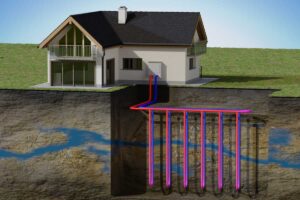Harnessing the Earth’s Power: The Future of Home Heating with Geothermal Energy
AC Repair Spring TX – Same Day Air Conditioning Service – Spring Texas
February 12, 2019
As homeowners increasingly seek sustainable solutions to home heating, geothermal energy emerges as a front-runner in eco-friendly and efficient heating technologies. Unlike traditional methods, geothermal heating taps into the earth’s natural heat, offering a greener alternative that doesn’t compromise on comfort. In this comprehensive guide, we delve into the nuances of geothermal heating for homes, exploring its benefits, how it works, and key considerations for installation, positioning it as the heating method of the future.
Understanding Geothermal Heating Systems
How It Works: Geothermal heating systems utilize the earth’s consistent underground temperature to heat homes. By circulating a fluid through underground pipes (ground loops), these systems absorb heat from the earth in winter and reverse the process in summer.
Components of the System: Key components include a ground loop, heat pump, and distribution system. The ground loop is a network of pipes buried underground; the heat pump exchanges heat between the earth and your home; and the distribution system delivers warm or cool air throughout your home.
The Benefits of Geothermal Heating for Your Home
Energy Efficiency: Geothermal systems are remarkably efficient, using only one unit of electricity to move up to five units of heating or cooling to a building.
Environmental Impact: These systems significantly reduce carbon footprints due to their use of renewable energy sources, leading to fewer greenhouse gas emissions.
Cost-Effectiveness: Despite higher initial installation costs, geothermal systems offer significant long-term savings on energy bills, often recouping the upfront costs within a few years.
Reliability and Longevity: With fewer moving parts and minimal maintenance requirements, geothermal systems are known for their reliability and can last for decades.
Is Geothermal Heating Right for Your Home?
Site Evaluation: A professional assessment of your geographical location and soil conditions is crucial for determining the feasibility of a geothermal system.
Initial Investment: The upfront cost can be higher than traditional heating systems, but tax incentives and long-term energy savings make it a cost-effective investment.
Space Requirements: Adequate land is necessary to install the ground loop; however, different configurations (horizontal or vertical) can be adapted to different land sizes.
Installation Process and What to Expect
Professional Assessment: Expert evaluation by specialists like Earth Power AC is key to a successful installation, ensuring that all geographic and architectural factors are considered.
Installation Timeline: The installation can vary based on the system’s complexity and land size but typically takes a few days to a week.
Post-Installation: Minimal disturbance to the landscape is expected, and any alterations are generally restored shortly after installation.
Final Thoughts Geothermal heating represents a significant stride towards more sustainable living. By choosing this eco-friendly heating method, homeowners can enjoy long-term savings, enhanced comfort, and the peace of mind that comes with reducing their environmental impact. For those considering making the switch, Earth Power AC stands ready to provide expert guidance and installation services.
Discover more about sustainable heating and cooling solutions at Energy.gov’s page on geothermal heat pumps. This page provides detailed information about geothermal heat pump systems, their working principle, benefits, and other relevant insights, making it a valuable resource for anyone interested in sustainable heating and cooling solutions.

 281-355-0430
281-355-0430



